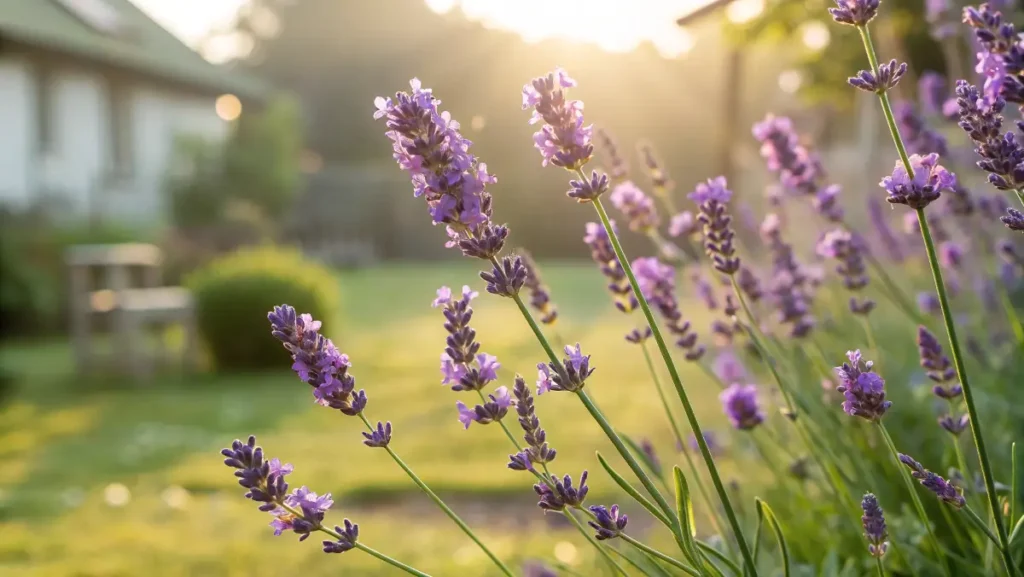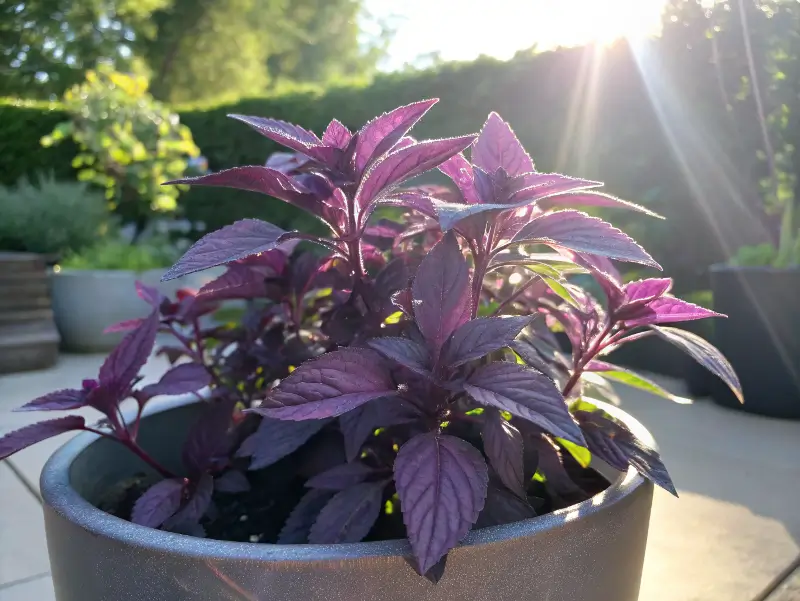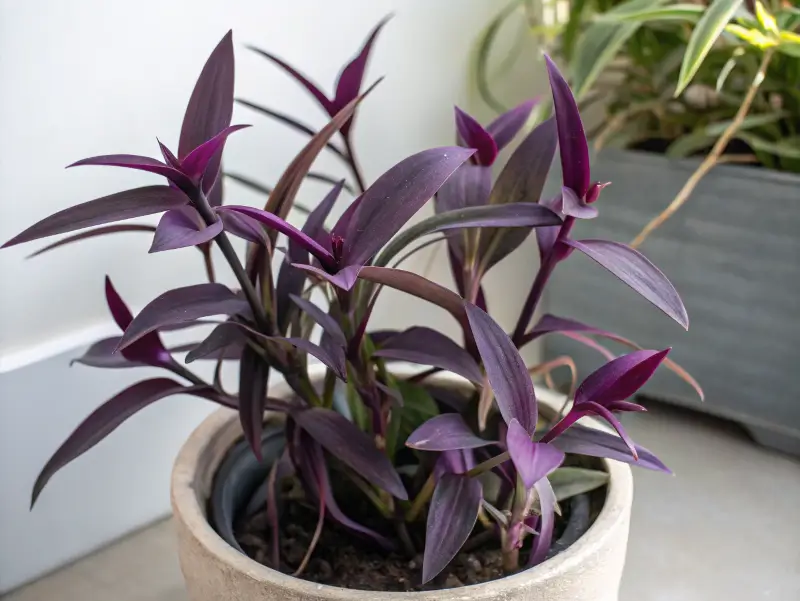
Discover everything about the purple plant—from its striking color to easy growing tips. This guide reveals its history, reasons people love it, and indoor or outdoor care best practices. I’ll share personal stories, fun ideas, and answer FAQs on which purple plants may fight bad energy and how to keep them healthy. Ready to add some purple? Go for it!
Table of Contents
Introduction to the Purple Plant
The Symbolism of Purple in Nature
Purple has always felt a bit magical, right? I remember seeing a purple plant peeking out among plain shrubs in my aunt’s yard during spring. It caught my eye instantly because those deep violet leaves stood out like a pop star on a red carpet.
- A Symbolic Color: Many cultures link purple to high status and spiritual vibes.
- Anthocyanins: These pigments give purple plants their bold tones.
- Seasonal Boost: In mid-spring, you can often spot purple blooms making their grand entrance.
Moreover, the color purple often signals calm and creativity. I’ve found that scattering a few purple plants here and there around my porch creates a chill environment for weekend hangouts.
Why Gardeners Love Purple Foliage
A purple plant can transform an otherwise plain green corner into a visual treat. Because these plants bring contrast and dimension, many gardeners prefer them for borders or focal points.
- Contrast Appeal: Purple leaves against green shrubs or white fences are pleasing.
- Easy Care: Lots of ornamental plants in the purple family are relatively low-key.
- Year-Round Enjoyment: Hardy purple perennials might even keep some color through cooler months.
I find these purple beauties to be conversation starters, too. Friends will drop by and say, “Dude, is that a real purple plant?” And I grin and say, “Sure is. I can show you how to grow one!”
The Purple Plant and Its Historical Significance
Ancient Cultivations of Purple Flora
Let’s turn back the clock. Purple cloth was rare and super pricey in old times because the dye was so hard to get. Naturally, when people discovered a purple plant in the wild, they were wowed. In certain ancient towns, purple blooms signaled wealth and even divine blessings.
- Demand for Purple Dye: Sought after by royals.
- Flowers as Status Symbols: Exotic purple flowers were prized and sold at high prices.
- Cultural Ties: Purple often appeared in rituals and ceremonies.
I imagine ancient gardeners bragging about their prized purple plants, much like how folks today post garden pics on social media. While the hype may have changed form, the love for these plants remains.
Cultural and Medicinal Importance
Lots of purple plants ended up with spiritual or medical uses. Some believed purple flowers could shield homes from negativity, especially the strongly scented ones like lavender. Personally, I think it’s sweet to see how different folks keep traditions alive.
- Fragrant Uses: Lavender was key in herbal mixes.
- Symbolic Warding: Some communities placed fresh purple blooms at doorsteps.
- Possible Health Perks: Anthocyanin-rich plants have been studied for antioxidant potential.
If you’re curious about official data, the U.S. Department of Agriculture sometimes shares interesting plant research. I’m a data nerd at heart, so that’s my go-to for thorough details.
Popular Purple Plant Varieties
Lavender and Its Calming Charm

No conversation about purple plants is complete without mentioning lavender. You probably know that dreamy smell—it’s pretty much the poster child of relaxation. Stick a couple of lavender pots by your porch, and your whole place will smell like a spa.
- Full Sun: Lavender craves direct light to stay lively.
- Allow Dry Soil: Water sparingly to avoid root rot.
- Bonus: Bees and butterflies love lavender.
I like clipping lavender stems and hanging them in my bathroom for a spa-like vibe. Plus, you can boil them up for homemade bath soaks, which is super fun on a chilly evening.
The Regal Purple Basil

If you’ve only tasted the usual green basil, you’re missing out. Purple Basil looks fancy and has a sweeter twist in flavor. I discovered purple basil at a local farmers’ market last summer, and my mind was blown after I added it to pasta.
- Warmth Lover: Plant it in late spring, once it’s not too cold.
- Quick Growth: Basil takes off fast in decent sun.
- Edible Delight: Use the leaves in salads and sandwiches.
Because it’s such a funky color, it also makes a nice ornamental plant in containers. Throw it near a Yellow Yucca Plant in your garden, and you’ll have an eye-catching color contrast right away.
Eye-Catching Purple Blooms in Landscaping
Purple Salvia for Bold Color
Salvia’s part of the mint family, and it has these cool purple spires. If you want a low-hassle purple plant that still packs a punch, salvia’s your buddy.
- Sun Requirements: Thrives in bright conditions.
- Water Needs: Moderate watering, but let the top inch of soil dry first.
- Minty Whiff: Stems have a faint mint smell, which is a neat surprise.
I remember planting salvia at the start of June. By July, my yard looked like a little purple sea, and local hummingbirds were having a field day.
Purple Coneflower for Pollinators
Though technically more pinkish purple, the purple coneflower (Echinacea) definitely fits the purple plant vibe. Pollinators go nuts for these blooms, and they’re relatively easy to maintain.
- Tough Cookies: They adapt to mild drought.
- Season of Bloom: Mid-summer to early fall.
- Tips: Deadhead the spent flowers to keep new blooms coming.
I love watching bright butterflies crowd around the coneflowers in July. It adds so much life and color to the yard. Plus, the purple petals complement any green shrubs you have around.
Vibrant Foliage: Beyond Green Leaves
Purple Heart (Tradescantia pallida) for Striking Contrast

If you see a creeping or trailing purple plant in a hanging basket, there’s a good chance it’s Purple Heart. The bold stems range from deep violet to almost maroon.
- Bright Light: It glows more purple in direct sun.
- Water Weekly: Let topsoil dry between waterings.
- Propagation: Clip a stem, pop it in water until it roots.
I find Purple Heart perfect for adding drama in places that might look dull otherwise. One time, I placed some near a stone walkway, and it turned that plain path into a mini showpiece.
Dusky Coleus Varieties
Coleus is known for multi-colored leaves, but some types show off dark purple or burgundy shades. These stand out in shady corners.
- Partial Shade: Direct sun can scorch the leaves.
- Moist Soil: Keep it damp but not soggy.
- Indoor Possibility: Coleus works well in pots, too.
I admit I’m a coleus collector. I tried a deep violet coleus once, and it added a moody flair to my porch collection. It’s wild how one single plant can switch up the entire garden’s feel.
Indoor Purple Plant Care and Maintenance
Choosing Suitable Purple Houseplants
You don’t have to keep every purple plant outside. In fact, many folks display them indoors for a flash of color. Some popular picks:
- Purple Passion Plant: Fuzzy purple leaves and a trailing habit.
- Tradescantia zebrina: Striped purple leaves that shine.
- African Violet: Compact plant with soft violet blooms.
I love scattering these around my living space. Whenever I walk by, they make me smile. My Purple Passion Plant sits on my desk, and I swear it’s my number one companion during long workdays.
Light, Water, and Soil Requirements
Indoor purple plants vary, but most enjoy bright, indirect light. That helps them keep their color.
- Avoid Overwatering: Let the topsoil dry out a bit.
- Check Humidity: If leaves curl, increase moisture or mist lightly.
- Soil Mix: A well-draining blend with perlite works best.
When I first started, I drowned a Purple Passion Plant with overly frequent watering. Learned my lesson! Now, I do the “finger test” to gauge if the soil is parched or still damp.
The Science Behind Purple Pigmentation
Anthocyanins and Plant Health
Anthocyanins are those compounds that give purple plants their jaw-dropping hues. But that’s not all. They help with the plant’s sun tolerance, almost like a built-in shield.
- UV Protection: Helps the leaves handle bright sunlight.
- Nutritional Bonus: In produce (like purple cabbage), anthocyanins may carry antioxidant traits.
- Temperature Impact: Cool nights often deepen the purple shade.
I noticed when the nights here in late spring got cooler, my purple plants started looking more vibrant. It’s like they decided to show off after a chill evening breeze.
Environmental Factors That Affect Purple Hues
If your purple plant looks pale, it might be due to lighting, soil pH, or watering habits.
- Sunlight: Too much shade can green up the leaves.
- Soil pH: Some plants shift color if conditions get too acidic or alkaline.
- Water Stress: Occasional mild drought can heighten that bold purple color.
I enjoy messing around with different spots in my yard. Sometimes, placing a purple plant near a reflective surface brightens its color. It’s amazing what a little experiment can do.
Surprising Purple Plant Hybrids and Crossbreeds
Experimenting with Purple Succulents
Succulents, especially Echeverias, sometimes show a soft lavender or lilac tinge. They look stunning on a windowsill where they can soak up morning sun.
- Fast Drainage: Succulents can’t handle soggy soil.
- Bright Light: Aim for a few hours of direct or filtered sunlight.
- Propagation: A single leaf can sprout roots if you place it on damp soil.
I have a tiny succulent station on my windowsill, and I love glancing over while I sip coffee. It’s a daily pick-me-up to see those mini purple rosettes shining in the sun.
Unique Purple Vegetables in Home Gardens
Who said a purple plant can’t be dinner? Purple carrots, peppers, and even purple cauliflower have gone mainstream in local markets.
- Seed Choice: Many seed catalogs stock anthocyanin-rich veggies.
- Raised Beds: Handy for controlling soil conditions.
- Harvest Fun: Pulling up a purple carrot is a thrill—trust me.
I remember the first time I sampled a purple bell pepper in a salad. My cousin was like, “Wait, peppers come in purple?” It was a total mind-bender. Tastes great, too!
Protecting Purple Plants from Common Pests and Diseases
Identifying and Managing Purple Plant Pests
Like it or not, pests target any live plant. Aphids and spider mites can pounce on your prized purple plants if you’re not careful.
- Soapy Spray: A gentle remedy for mild infestations.
- Regular Checks: Inspect leaf undersides and the soil surface.
- Natural Allies: Ladybugs love munching on aphids.
I keep a small container of neem oil in my tool shed. It’s my go-to for quick treatments when I spot trouble. Saves me from bigger problems down the line.
Preventative Measures and Natural Remedies
Prevention’s always simpler than crisis management. For instance, give your plants enough breathing room. Crowded plants raise humidity, which can invite fungal issues.
- Spacing: Ensure airflow among containers and garden beds.
- Mulching: Helps manage moisture.
- Marigolds: These blooms can deter some pests when planted nearby.
Oddly enough, a buddy of mine swears by sprinkling crushed eggshells around the base of certain plants. He believes it keeps slugs away. I’ve tried it, and hey, it doesn’t hurt.
FAQs About Purple Plants
What is the name of the purple plant?
This question always makes me smile. There’s not just one plant that folks call the “purple plant.” It could be Purple Heart, Purple Passion Plant, or a vibrant coleus. Some people might even refer to a sweet-smelling lavender. Whenever someone says, “Dude, what’s that purple plant?” I usually ask them to describe the leaves or shape to pinpoint the exact species. With so many varieties, it’s like a treasure hunt.
What is the name of the plant with purple stripes?
You’re probably thinking of Tradescantia zebrina, also called Wandering Jew. It features purple and silver stripes on each leaf. I’ve had one for years, and it’s a pro at sprucing up a dull corner. Just cut a stem, place it in a cup of water, and wait for those roots to appear—it’s super easy to share with friends.
What is the purple flowering plant to ward off evil?
Lavender is often popped into this category. Many traditions say lavender keeps negative vibes away. Whether that’s true or not, it does keep my place smelling great. I’ve also read about certain folks hanging lavender above doorways for that extra pinch of good mojo.
How do you take care of a purple money plant?
The “purple money plant” can refer to a few species, but Purple Passion Vine or certain Pileas are typical examples. Basically, keep it in moderate, indirect sun, water it when the soil’s dry, and use a lightweight potting mix. If the leaves start drooping, give it a drink. Just don’t overwater, or you’ll have a soggy mess. I like to rotate mine every few weeks to keep it from leaning toward the light.
